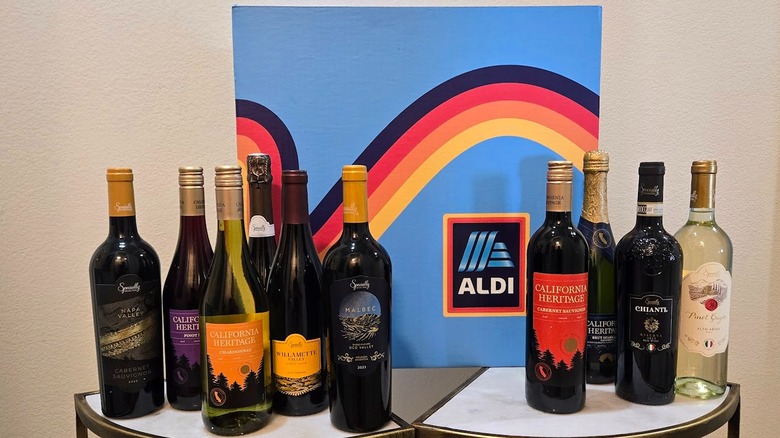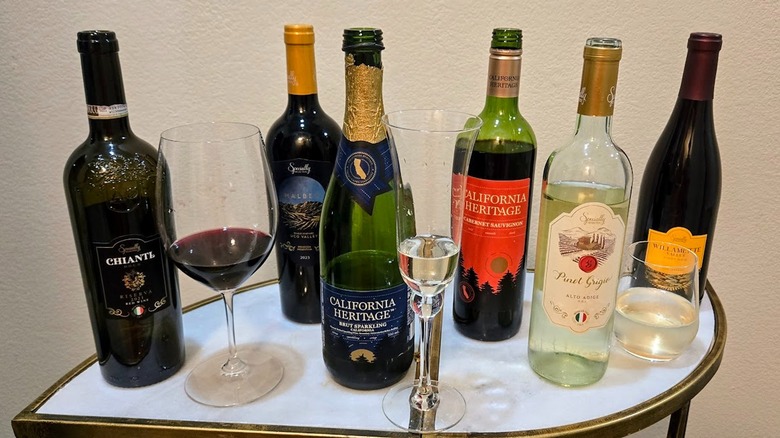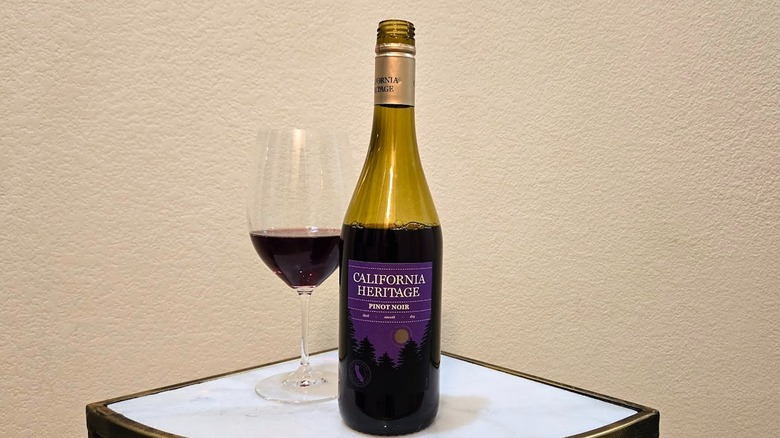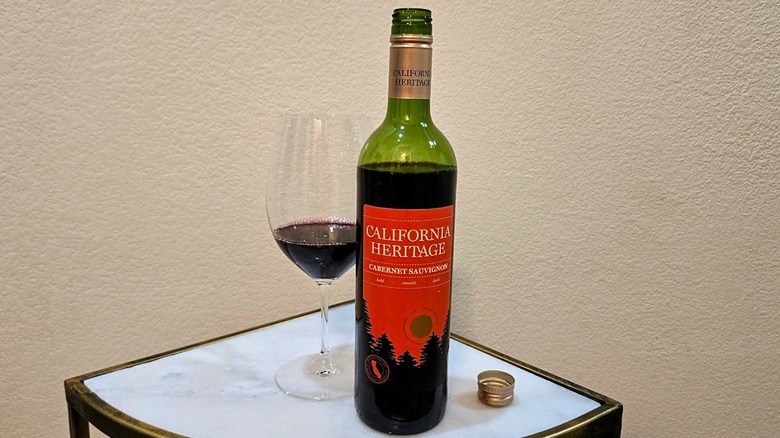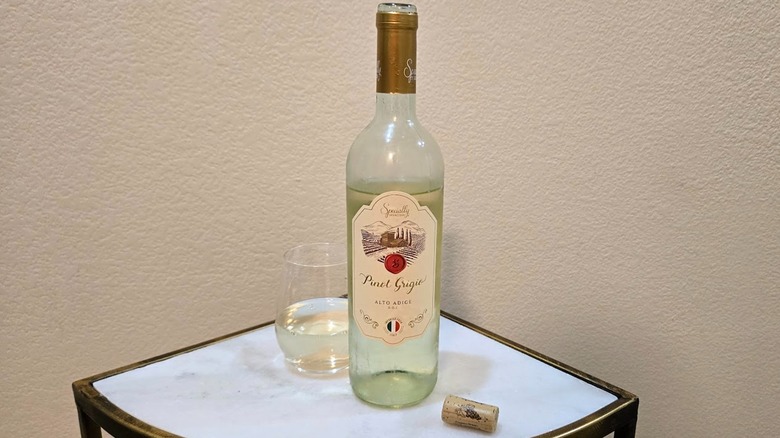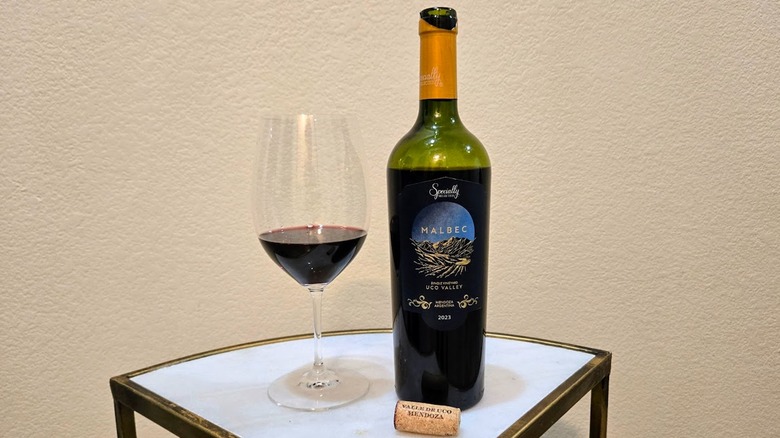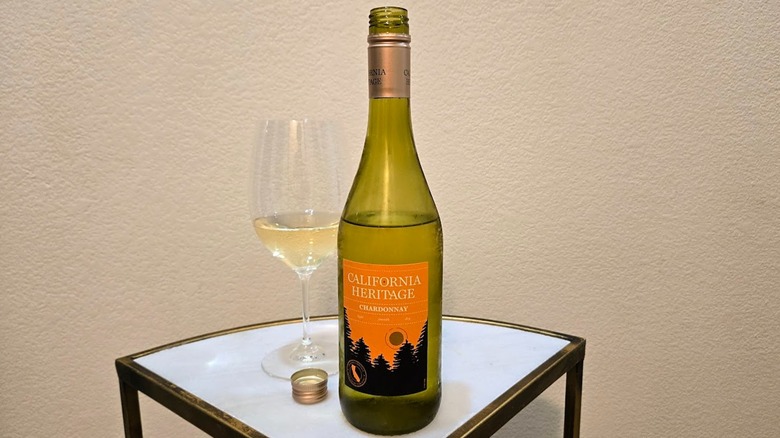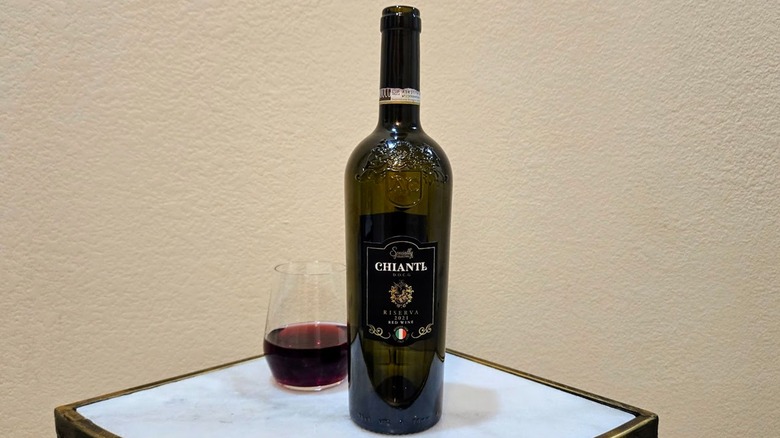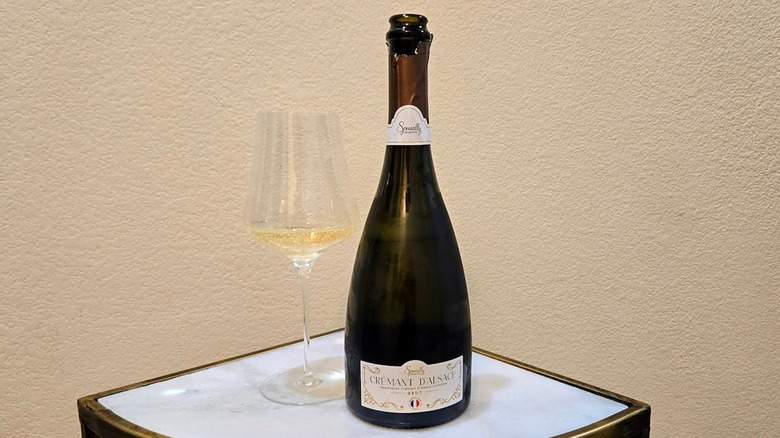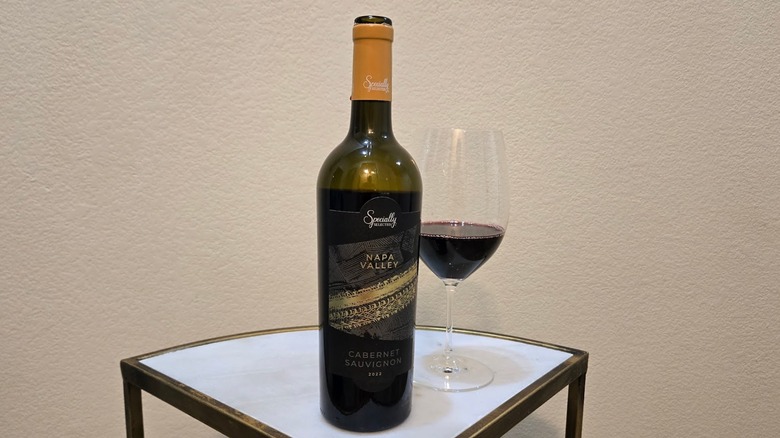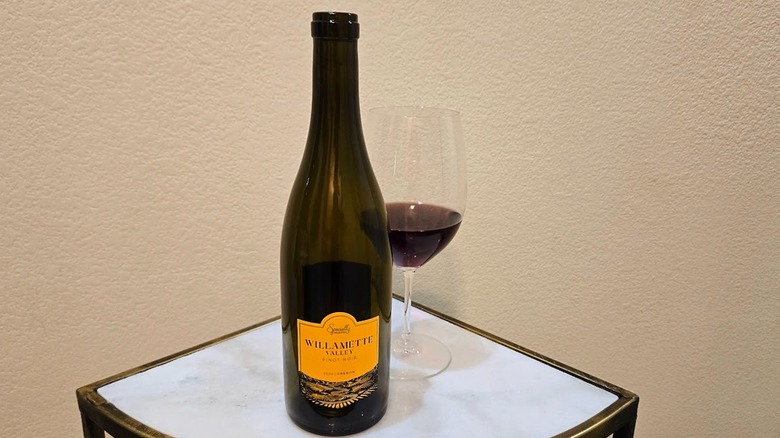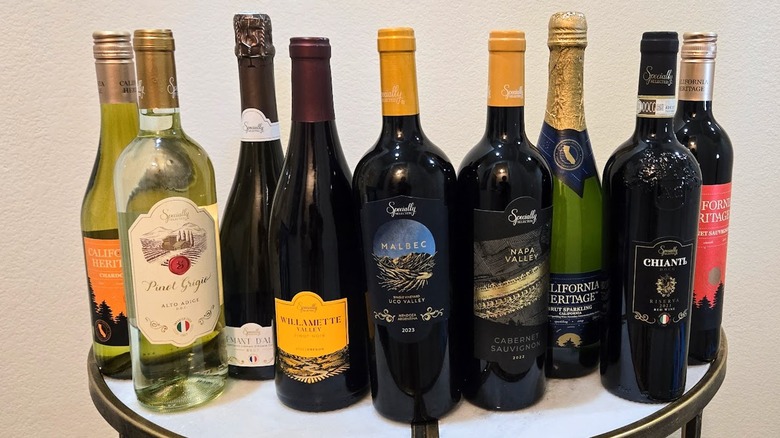10 Private-Label Aldi Wines, Ranked By A Sommelier
Discount grocery stores, like Aldi, are an appealing option for those looking for affordable items to feed their families. Since its founding, the German-based international grocery store's business model has always been to provide household goods at low prices, selling many items under an Aldi private label brand, cutting out the middleman. According to Aldi's website, over 90% of the items the grocery store sells are one of its private label brands, including in its wine department, which continues to improve and expand.
As Aldi's footprint continues to grow in America, with over 2,400 stores open to date and growing, we wanted to try some of these new offerings to ascertain the quality. We reached out to Aldi to obtain a group of wines, which we have ranked after researching details on their provenance, production, sustainability, interviews, and most importantly, taste tests. I drew upon my experience as a certified sommelier and wine professional with 20 years of experience in the beverage industry to rank 10 of Aldi's top private label wines.
Some recommendations are based on firsthand impressions of promotional materials and products provided by the manufacturer.
What are Aldi's private label wines?
Aldi's business model is similar to that of Trader Joe's, which makes sense as the connection between Trader Joe's and Aldi runs deep. Like TJ's "Two Buck Chuck" Charles Shaw wines, Aldi's Winking Owl Wines line the store's wine aisle, offering selections for around $3 a bottle. However, Aldi wanted to give its customers more. We spoke with Arlin Zajmi, Director of National Buying for Adult Beverages at Aldi, about the grocer's wine portfolio and two new collections within its private label brands. Zajmi shared that in 2023, after two years of development, Aldi launched its private label Specially Selected wines.
Like other private label Specially Selected products, including items like olive oil, nuts, cheese, and sauces, Aldi aims to offer a portfolio of wines of high quality without a high price. Aldi drew upon its decades of experience and relationship building while sourcing products worldwide to produce a portfolio of wines, with each selection costing under $15 a bottle from national and international regions.
Furthering its wine offerings, in early 2024 Aldi introduced its California Heritage collection of wine. The California Heritage collection of wines includes nine varieties, all under the state-wide California appellation, with each bottled without a vintage designation. Partnering with one of the largest wine producers in the country, E. & J. Gallo, each wine selection costs under $5 a bottle.
10. California Heritage Pinot Noir
California is the mecca of wine growing in America. It is one of the most expansive states in the country with a multitude of climates, soils, elevations, and growing conditions, making it conducive to growing warm weather varieties, like tempranillo, syrah, and sangiovese, to cooler climate options like chardonnay and pinot gris. Pinot noir is also one that typically thrives in cooler climates, where the fruit's delicate characteristics and fresh aromatics are maintained. However, while the alcohol is only 12.5%, the California Heritage selection shows characteristics of over-ripened fruit, often present in warmer growing conditions.
The effect is likely from the hot fermentation technique used during the wine's production. Fermenting the fruit at high temperatures ranging from 88 degrees Fahrenheit to 92 degrees Fahrenheit can help soften the tannins and extract bold flavor. In higher tannin wine, like a cabernet sauvignon or mourvedre, high temperatures can create a wine that is more ready to drink upon release with a smooth, velvety palate. The process takes less time than a cool fermentation. However, using the technique to craft wine from delicate, thin-skinned fruit, like pinot noir, caused the aromas and flavors to fall flat. The resulting wine has little expression of the terroir or location in which it is grown, which is often one of the defining factors in quality pinot noir. Instead of classic floral, fruity aromatics and lively freshness, the wine shows notes of stewed berries with only slight acidity, placing it at the bottom of the ranking.
9. California Heritage Sparkling Wine
Aldi crafts its California Heritage Brut Sparkling wine from three highly productive wine grapes including, French colombard, burger, and Thompson. While the colombard and burger's origins are both from France, the Thompson is primarily a table grape. Each variety has become popular in California due to its resiliency and productivity, especially in warm, dry climates.
Aldi harvests the California appellation grapes at night, when temperatures are cool, and ferments the fruit at low temperatures, presumably to help retain the fruit's natural acidity. The sparkling wine's production includes the Charmat method, using pressurized tanks to create the wine's bubbles to ensure the sparkler has a youthful freshness in the glass.
While the 10.5% alcohol sparkling wine begins with a frothy mousse, the bright effervescence of the bubbles quickly dissipates from the glass after pouring, leaving a wine with a surprisingly sweet palate that is not indicative of a brut-style wine. The sugar level in the sparkler is much less than what is in a classic frozen margarita, and a fraction of what your favorite Starbucks drink likely has; the sugars do not meld with the fruit's natural acidity, producing an unbalanced wine. Aldi's option is a fine choice for mixing with orange juice for a morning cocktail, as the juice will help balance the flavor, particularly if you are making mimosas for a crowd. However, we suggest skipping the $4.95 option if you prefer sipping your glass of sparkling wine without having to add juice.
8. California Heritage Cabernet Sauvignon
The fermentation of the California Heritage Cabernet Sauvignon fruit is the same hot technique that Aldi uses for its pinot noir. However, when using the higher temperature fermentation on a bold, higher tannin variety, it brings softness to the palate of the wine. After fermentation, the wine ages briefly on oak, which for the $4.95 price is likely oak chips or staves, giving the toasted spice, vanilla, and milk chocolate flavors without the high price tag of aging the wine in oak barrels.
The 13% alcohol selection opens with ripe berries and toasted oak aromas. Flavors of black cherry, berry, and vanilla follow. While the overall wine is not complex and shows more fruit-forward flavors than structure or concentration, which keeps it from climbing any higher in the ranking, the 100% cabernet sauvignon selection has an approachable, effortless style that can pair well with food. We recommend enjoying it with beefy proteins, like broiled meatball skewers or sausage burgers with peppers and onions.
7. Specially Selected Pinot Grigio DOC
Italy's Alto Adige region is one of the premier places to produce pinot grigio wine in the world. The far northern region rests almost at the border of Austria in the foothills of the Italian Alps, where steeply sloped, cool climate, and hillside vineyards produce fruit with vibrancy, energy, and freshness. The region is part of the larger Trentino-Alto Adige, home to the popular Santa Margherita Pinot Grigio. Santa Margherita put the pinot grigio variety on the consumer map in America. When we spoke with Arlin Zajmi, he shared that the style inspiration for Aldi's Specially Selected Pinot Grigio was Santa Margherita, showing fruit-forward citrus, melon, and stone fruit favors.
In tasting this 12.5% alcohol wine, we found it to have a youthful freshness, nice acidity, and light body. However, the wine lacked well-rounded, full-flavored fruit, showing instead a slight bitterness of unripened fruit that lingered in the background. Trying it with food softened this bite and enhanced its enjoyability, which is how we recommend enjoying it. At under $10 a bottle, the wine costs a fraction of Santa Margherita's. However, its flavor and price are comparable to other Alto Adige pinot grigio wines. Though from a premium Denominazione di Origine Controllata (DOC) region with government-regulated quality controls, the wine's overall character keeps it from climbing higher in the ranking.
6. Specially Selected Malbec
Aldi's Specially Selected Malbec was one of the store's first selections when it introduced its higher-end tier of wines. Speaking with Arlin Zajmi, he shared how pleased the retailer was to provide a wine that would highlight single vineyard fruit from Uco Valley within the Mendoza region. He said they could have branded the wine simply as Mendoza, but Uco Valley within the greater Mendoza region is such an ideal place for growing the country's signature variety that the store was delighted to feature it on the bottle. Uco Valley's high elevations, resting in the foothills of the Andes Mountains, create wines with energy and freshness as the cool climate helps lock in natural acidity within the fruit.
Producer Belhara Estate crafts Aldi's 2023 vintage, 100% malbec to be youthful and fresh, undergoing stainless steel fermentation, and, from what we can tell by the taste, little to no oak aging. With 13.3% alcohol, the $9.99 wine shows red and black berries, cherries, woody herbs, and tobacco. While the wine was enjoyable, placing it in the middle of Aldi's options. The wine is comparable to other inexpensive malbec wines, like a similar single vineyard, Uco Valley estate-grown malbec wine that Belhara makes for Trader Joe's that costs one dollar less than Aldi's option, keeping the wine from a higher ranking on the list.
5. California Heritage Chardonnay
The best wine we tried in the California Heritage collection was the chardonnay. The wine has a bright, crisp freshness, likely thanks to using a cool, slow fermentation technique to turn the fruit's juice into alcohol, with temperatures ranging between 55 and 62 degrees Fahrenheit. Keeping the temperatures low ensures the chardonnay's floral and fruity aromatics come through while delivering a palate that pops with acidity and fruit-forward flavors. Storing the wine in stainless steel, without utilizing any oak in its short aging, further ensures the wine will deliver this youthful freshness in the glass once bottled.
The $4.95 California appellation chardonnay wine has a modest 12.5% alcohol and shows notes of ripe pear, apple, melon, and golden citrus. It is the type of wine you can enjoy with a simple dinner of roast chicken or fish, and the $4.95 price makes it one of the best budget chardonnay wines on the market today.
4. Specially Selected Chianti Riserva DOCG
Vignerons within Italy's Chianti region have been crafting wine for hundreds of years. While the area nestled within Italy's Tuscany region did not become an official Denominazione di Origine Controllata (DOC) guaranteeing governmental quality controls within a designated production zone until 1967, the area was first specified as the Chianti wine zone in 1716. In 1984, the region officially became a Denominazione di Origine Controllata e Garantita (DOCG), making wines from the area adhere to the highest quality and production controls.
For wines from the region, 70% must contain the sangiovese variety, creating plush wines with juicy, fruit-forward flavors, high acidity, and bold tannin. These are food wines that go particularly well with Italian food staples like pasta and pizza. By law, all Chianti Riserva wines must be at least 12% alcohol and age for at least two years. Aldi's Specially Selected Chianti Riserva is crafted from 100% sangiovese and has been aged for two years in oak. After bottling, it took an additional three months before release to help the wine settle and flavors meld.
The 2022 vintage red wine is well integrated, showing varietal authenticity with notes of blackberries, dried herbs, wildflowers, and savory balsamic. The 14.5% alcohol Chianti is one of the best wines to pair with different types of pizza thanks to its balance of fruit, tannin, and freshness. Its overall flavor for the incredible price of $7.99 ranks the wine high on our list, just below our top three options.
3. Specially Selected Cremant d'Alsace
One of the new offerings in the Specialty Selected portfolio is an Alsatian crémant, a type of sparkling wine from the Alsace region of France. The area, which rests on the border between France and Germany with high-elevation vineyards and a relatively cool climate, is known for producing highly aromatic, refreshing sparkling and white wines from varieties like riesling, gewurztraminer, and pinot gris.
For Aldi's selection, its non-vintage Crémant d'Alsace is a blend of auxerrois, a full-bodied white grape from the area, and zesty pinot blanc, with pinot gris, pinot noir, and riesling. The combination of auxerrois and pinot blanc is typical for crémant from the region, with the characteristics of each complementing each other. French law indicates the harvest of the wine's fruit occurs by hand; it is whole cluster pressed and ages for a minimum of nine months on the lees (dead yeast strains), adding texture and richness to the wine.
Upon pouring the wine lively bubbles lift in the glass and continue dancing on the tongue from the first sip to the last. Though one of the most expensive options from the producer, the wine's price is on par with other Cremant d'Alsace wines from the region. Overall, Aldi's option is tasty, delivering everything we would want in a sparkling wine. The wine layers golden citrus and ripe orchard fruit with bitter grapefruit pith and marzipan, and its lively bubbles linger throughout, ranking the wine third on our list.
2. Aldi Specially Selected Napa Valley Cabernet Sauvignon
Aldi's Specially Selected Napa Valley Cabernet Sauvignon is one of the most expensive selections for the store's private labels. However, it is rare to find a high-quality cabernet sauvignon from the prestigious California region for under $15.00. This price is especially impressive, considering an acre of vineyard land in the valley can sell for hundreds of thousands of dollars.
Aldi's 2022 vintage option adds a few additional grape varieties to its cabernet sauvignon base, including merlot, malbec, and petite sirah, to create a 13.5% alcohol red wine. After fermentation, the wine ages for 14 months in French oak. The use of French oak is also surprising for the price. While French oak is the preferred type of oak for aging Bordeaux varieties, it is also very expensive, much more so than other options like American or Hungarian oak.
Upon opening the bottle, aromas of black fruits, wildflowers, and dusty leather lift from the bottle. The wine's first sips were softer than we expected, both from the wine's aromas and the general pedigree of the region. After allowing the wine to breathe in the glass, allowing oxygen to help open the wine, flavors of blackberry, black cherry, tobacco, and allspice began to reveal themselves, producing an enjoyable wine that takes the second to top spot in our ranking. We suggest picking up a bottle along with one of Aldi's best cuts of meat to enjoy on your next date night.
1. Specially Selected Willamette Valley Pinot Noir
Willamette Valley, Oregon, is a premier growing site for pinot noir fruit. The region's mix of soil types, including volcanic and marine sedimentary soils, gives the wine an earthy, mineral note. The close proximity to the Pacific Ocean brings cooling breezes through the vineyards that keep the fruit fresh and acidity bright, even during the warmest parts of the growing season. Due to the pedigree of the fruit, it is impressive to find a well-made Willamette Valley AVA pinot noir that is under $14, which makes Aldi's $13.99 selection a rare find.
With a bright, alluring garnet color and balanced 12.5% alcohol, the 2022 vintage pinot noir shows regional authenticity with classic wild strawberry, red cherry, wet leaves, and earthy forest floor characteristics. While the wine is not overly complex or highly structured, it is a fine everyday bottle selection displaying the qualities we look for in pinot noir, pairing nicely with Pacific Northwest foods, like roasted salmon or earthy mushroom risotto, placing it number one on our list.
Methodology
To create this ranking, I utilized my skills as a certified specialist in wine and a seasoned sommelier who has been reviewing and writing about wine for decades. I have traveled throughout each region included in this ranking, tasting the wines and learning the relationship the terroir has with the grapes.
After interviewing Aldi's National Wine Buyer, Arlin Zajmi, to understand the goals the grocery store has for the private label wine program, I researched details on the wine's production and provenance and taste-tested each selection, understanding that wine does not have to be expensive to be delicious. Still, it has to be well-made and representative of the variety and the place that it comes from.
